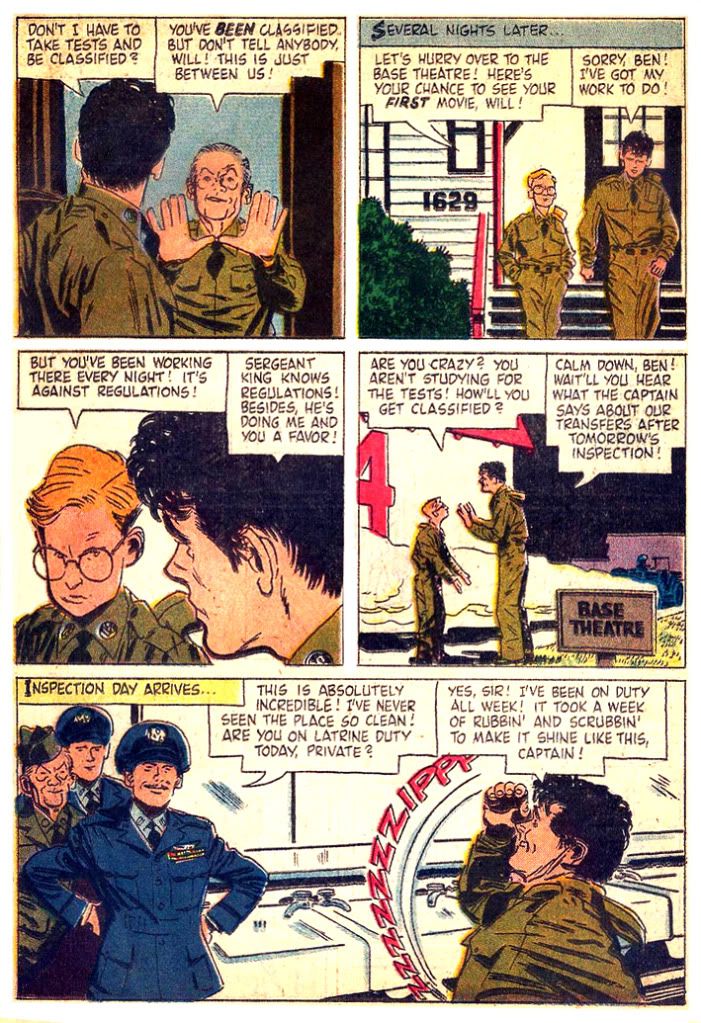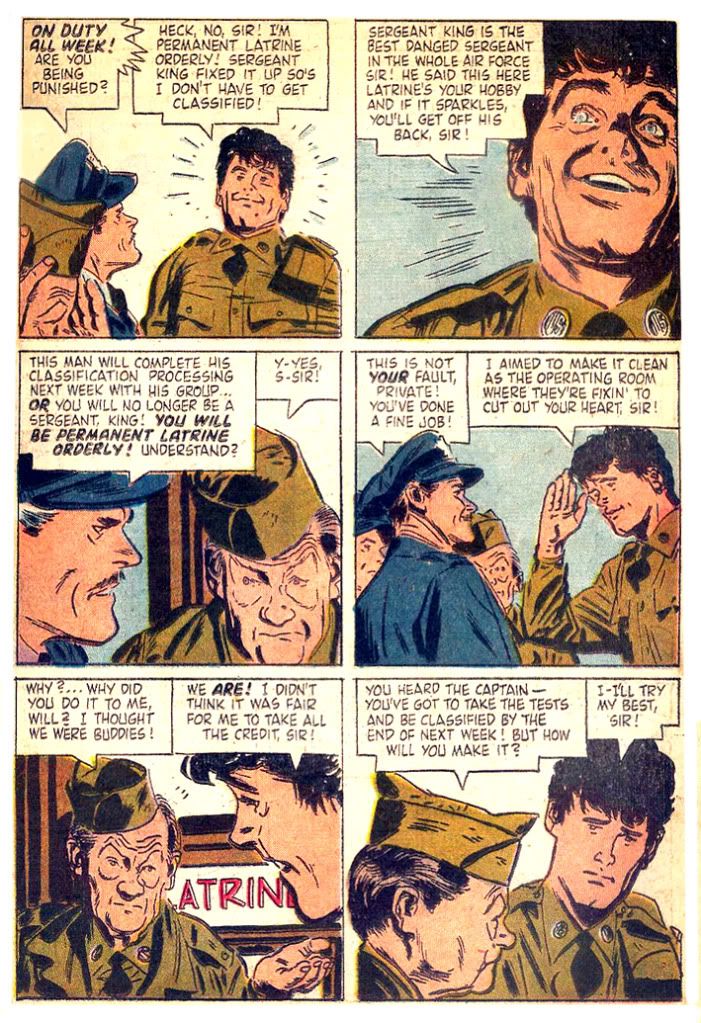And here's Toth's take:
As you can see, Toth's staging is quite different from the film's. Toth has flipped the composition-- in the movie, the captain enters from the right, but here from the left. This has to do with directing the eye through the page. It's called storytelling, for those of you who like to simply reproduce photographs or still frames. For some reason, he's added an officer. This officer isn't present in the film, says nothing, does nothing and adds nothing to the comic book page. I think of Toth as more an artist of subtraction, so it seems uncharacteristic of him to stick some extraneous guy in a scene, but there he is.
Toth doesn't attempt perfect likenesses of the characters, either. Study the faces. Toth's Bartlett Robinson, Myron McCormick, Nick Adams and even his Andy Griffith are only approximations. I've always felt Adams resembles the later Our Gang member Froggy in No Time For Sergeants; he doesn't really, except here in the comic where he could be played by the same actor. But the important thing to note is how Toth goes for the gist rather than either a portrait or a caricature. There may have been image licensing problems, or maybe this was a conscious decsion on Toth's part. Whatever the reason, it frees Toth from the constraint of relying too much on photo reference-- although from some of the poses it's obvious he saw some or screened the film beforehand-- and allows him to manipulate his figures freely according to his needs and, more importantly, animate the faces. A good storyteller "acts" for his or her characters, and this means giving each one distinctive facial expressions and trying not to repeat them. Go read John Kricfalusi's blog where he writes extensively about acting in animation. It holds true for comics.
Because Toth was a superb storyteller and artist each of his characters has a look that remains consistent within the story and wonderfully plays each scene (the sergeant's hands upraised in dismay despite his head being cropped by the lower half of the first panel on page two, the Griffith character's happily clueless reaction in the second), and those are far more important than exact likenesses. I can't think of anything that spoils my suspension of disbelief when reading a comic than some static, overly-rendered attempt at a perfect likeness after a lot of panels where there's only a passing resemblance. Only Al Williamson could do that and get away with it. And even worse is a failed attempt at a portrait. DC's Star Trek books and the later issues of Topps' The X-Files used to just kill me with that kind of stuff. A page and a half of tiny Picards or Mulders and then a big, expressionless, crosshatched head staring straight out at you-- with crooked eyes or the cheeks too flabby.
Better just to internalize the characters and put your own vision on the page the way Toth does here-- and Charles Adlard so brilliantly did in the first issues of The X-Files. I wonder how the licensing people at 20th Century Fox Television felt about that. According to Bruce Canwell in Genius, Isolated: The Life and Art of Alex Toth, at one point while working for Dell, Toth got grief from Danny Thomas when he drew Thomas's nose too large for comfort in the comic version of The Danny Thomas Show. Zazu Pitts complained he made her look too old. She was 66 when Toth drew her in the Dell adaptation of her show Oh! Suzanna. Dealing with Hollywood must be a real bastard at times.
Licensing. Nowadays any property worth its CGI bombast has statues, toys, t-shirts and all kinds of add-on "universe-building" novels and comics. Back before I was born, movies like No Time for Sergeants got only these funky comic book adaptations-- and who the hell knows what kid this was really meant for? You have your Superman, your Batman, maybe a gruesome dog-eared EC Tales from the Crypt... and then this. What self-respecting kid would turn up at the treehouse with No Time for Sergeants rolled up in his back pocket? Pre-teen Bartlett Robinson fans? Precocious aficionados of character actors like Myron McCormick? Mervyn LeRoy fanatics? Or me? I was all of those things at one time, and while I certainly love this movie if I had my choice I'd prefer a Toth-drawn adaptation of Mr. Roberts.
Well, I'm digressing. Let's just say if you're obsessive enough to need the definitive portrait of Andy Griffith in this story, he's right there on the comic's photo cover.
For some reason, though, Toth sticks Griffith's garrison cap in his shirt epaulet, a detail conspicuously absent from the film scene. No Time for Sergeants features the first on-screen pairing of Griffith with Don Knotts (he made his Broadway debut playing the same part in 1955), who would later play Deputy Barney Fife opposite Griffith as Sheriff Andy Taylor. The No Time adaptation leaves out their brief scene in the interest of page count. But don't worry-- Knotts would get his shot at comic book immortality a few years later in Dell's adaptations of The Andy Griffith Show.
At the end of the book he gets the pony anyhow!



No comments:
Post a Comment